
Developing trade and port histories: Outports
- Introduction
- Ardrossan
- Ceduna/Thevenard
- Connecting Kangaroo Island
- Fleurieu Peninsula Ports
- Fleurieu Peninsula Ports continued
- Klein Point
- Port Augusta
- Port Elliot
- Port Germein
- Port Giles
- Port Lincoln
- Port MacDonnell
- Port Pirie
- Port Victoria
- Port Wakefield
- Robe
- Victor Harbor
- Victor Harbor continued
- Wallaroo
- Whyalla and Port Bonython
 The outports of South Australia are all of those ports along the coast other than Port Adelaide. These small ports developed as the demand for goods arose among the increasing number of rural communities. As agricultural and pastoral lands became productive and had product to export, use of the ports increased. Jetties were gradually constructed to facilitate this trade. Ketches and schooners plied the outports carrying cargoes that were not financially viable for larger vessels, or served as lighters for vessels that moored in deeper waters, particularly in the gulfs. The copper discoveries of the 1840s led to the establishment of the first outport at Port Wakefield. Copper was South Australia's first export and aided the colony's financial recovery from the near bankruptcy of the late 1830s. Further copper discoveries at Kadina saw a more convenient port established at Wallaroo. Port Adelaide however remained the chief South Australian port, particularly with the establishment of railways. Some outports, such as Port Wakefield, lost their seaborne trade as a result, but diversified in other ways.
The outports of South Australia are all of those ports along the coast other than Port Adelaide. These small ports developed as the demand for goods arose among the increasing number of rural communities. As agricultural and pastoral lands became productive and had product to export, use of the ports increased. Jetties were gradually constructed to facilitate this trade. Ketches and schooners plied the outports carrying cargoes that were not financially viable for larger vessels, or served as lighters for vessels that moored in deeper waters, particularly in the gulfs. The copper discoveries of the 1840s led to the establishment of the first outport at Port Wakefield. Copper was South Australia's first export and aided the colony's financial recovery from the near bankruptcy of the late 1830s. Further copper discoveries at Kadina saw a more convenient port established at Wallaroo. Port Adelaide however remained the chief South Australian port, particularly with the establishment of railways. Some outports, such as Port Wakefield, lost their seaborne trade as a result, but diversified in other ways.
The move to containerisation in the late 1950s saw a change in cargo handling practices: bulk handling facilities saw the Port and some of the outports gain ground, while others dwindled. While there are now fewer ships at Port Adelaide and in the outports than in the past, the tonnages shipped are greater than ever.
Ardrossan
The town of Ardrossan, at the northern end of St Vincent Gulf, on Yorke Peninsula, was proclaimed in November 1873. Seven months later the residents petitioned for a jetty, and construction began in 1876. This was 420 feet (128 metres) but was extended in 1880 and again in 1883 to a final length of 433 metres. At the same time the jetty was widened to accommodate two sets of rails, and an approach to the jetty and goods shed was also constructed. Ardrossan was never connected to the state's rail network, and was serviced twice weekly by a steamer from Port Adelaide.
The invention and development by Richard Bowyer Smith of the stump jump plough between 1876 and 1880, and the opening of a manufacturing plant in Ardrossan in 1880 provided the town with a manufacturing base in an otherwise rural region that grew predominantly wheat and barley. Stump jump ploughs were exported interstate and the business expanded and diversified before it finally closed in the 1920s. By then grain exports were in full production rising from 52,254 bushels of wheat and 549 bushels of barley in 1880 to 243,840 bushels of wheat, 218,275 bushels of barley in 1950. Wheat and barley production have continued to grow.
In 1950 BHP (Broken Hill Proprietary Ltd) began mining a deposit of fine grade dolomite just south of Ardrossan, and applied to the South Australian government for the construction of a crushing plant and a jetty and conveyer belt facility at Ardrossan. Permission was granted subject to the belt and jetty being made available for the shipment of the wheat and barley from the region and salt from the nearby salt pans at Price. With agreement to this, work began on grain silos and bulk handling facilities. The first shipment using these facilities was on 21 January 1953.
Ardrossan's bulk handling facilities were the first in South Australia and are now the third largest in the state. The jetty is 931 metres long with a 'T' head which provides berths 409 metres long. The grain elevator tower is 74 metres, the largest in the state, and the conveyor belt can load 2,400 tonnes of dolomite, 900 tonnes of grain or 750 tonnes of salt per hour. This new jetty was built several kilometres south of the old one, which continued to be used by fishermen and tourists. It received a major upgrade in 1998, and its length was reduced to 414 metres.
The Port of Ardrossan is operated by ABB Grain Ltd. The BHP dolomite facilities and quarry are now operated by One Steel.
Further reading:
Sanders, ML. Ardrossan and Cunningham Ward Centenary Book, 1873-1973, Ardrossan, District Council of Yorke Peninsula, 1973?
Back to Ardrossan Easter Celebrations: 1873 to 1955. Ardrossan, 1955
Collins, Neville. The jetties of South Australia: past and present, Woodside, Neville Collins, 2005
Websites:
Flinders Ranges Research: Ardrossan
ABB Grain: Port of Ardrossan then go to About what we do then Maritime Services
Yorke Peninsula history and heritage: historic ports: Ardrossan
Items 1 - 12 of 33














